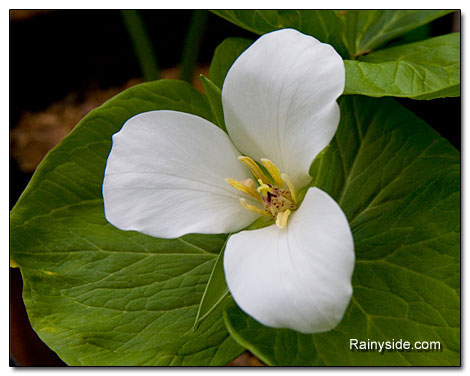Trillium camschatcense
OBANANO ENREISO, WAKE ROBIN, WOOD LILY
syn. T. kamtschaticum, T. camtschaticum, T. pallasii, T. erectum var. japonicum
Family: Trilliaceae
Pronounced: TRIL-ee-um kam-shat-KEN-see
Quick Jumps
Growing Guide
Rainy Side Notes
GROWING GUIDE

Origin:
East Asia.
Plant Group:
Perennials.
Hardiness:
Sunset zones: Not listed.
USDA zones: 5-8.
Heat zones: 8-5.
Mature size:
Height: 10 inches (25 cm).
Width: 8 inches (20 cm).
Flowering period:
Early to late April.
Flowering attributes:
Slightly fragrant flowers with ovate, 3 ¾-inch, white to creamy-white petals that flush to purple as the flower ages, and dark green, pointed sepals.
Leaf attributes:
Dark green, diamond-shaped leaves.
Light:
Full to partial shade.
Soil:
Moist to boggy, humus rich, acidic to neutral soil.
Feeding:
In fall, top dress with leaf mold.
Propagation methods:
Sow seed when ripe and place in cold frame over winter. 545 days to germinate (double dormancy).
When leaves begin to die down in late summer and early fall, lift and divide rhizomes of established plants.
Pruning methods:
n/a
Pests and Diseases:
Deer, slugs and snails may be a problem for young plants. Some problems such as fungal spots and rust may occur.
Rainy Side Notes
In my not-always-humble opinion, this clump-forming perennial—Trillium camschatcense—is one of the best for the garden. When I look at this flower, many descriptive adjectives dance around in my mind, such as elegant, exquisite, and pure. The first time I spied this plant growing in a woodland garden, I knew I wanted to grow it in my own shady space. The flowers are similar to our beloved Northwest’s native species, Trillium ovatum.
Its native lowland habitat consists of mixed deciduous forests of Alnus (alder), Fraxinus (ash), Magnolia, Quercus (oak), Tilia (basswood), and Ulnus (elm). In higher subalpine habitat, it grows under the canopy of Betula (birch). Dan Hinkley in The Explorer's Garden: Rare and Unusual Perennials
observed the perennial growing in densely shaded and moist forests in its native haunts. In his former garden at Heronswood, he grew it in boggy conditions alongside the American native skunk cabbage—Lysichiton americanus—and its European counterpart—L. camtschatcensis.
These slow-to-establish trilliums are long-lived to 20 years old or more; some are reportedly as old as 50 years. They require consistently moist conditions and can suffer during our typical Northwest summer drought. I planted mine under my seven sons tree—Heptacodium miconoides—another moisture loving plant. Their April floral show makes them worth growing in a large group in the shade.
Trillium comes from the Greek words for tri, meaning three, and kyrtos, meaning humped; which refers to each petal’s swollen base. The epithet camschatcense comes from the Kamchatka Peninsula where Ker Gawler first described it (1805). Later the plant took on different names; however, it has come full circle back to its first valid published name. The Japanese commonly call it obanano enreiso, which means large-flowered trillium.
Deer love to eat them, so it is important to protect them from your local herds.
Photographed in author's garden.

Gardening for the Homebrewer: Grow and Process Plants for Making Beer, Wine, Gruit, Cider, Perry, and More
By co-authors Debbie Teashon (Rainy Side Gardeners) and Wendy Tweton
Copyright Notice | Home | Search | Perennials

